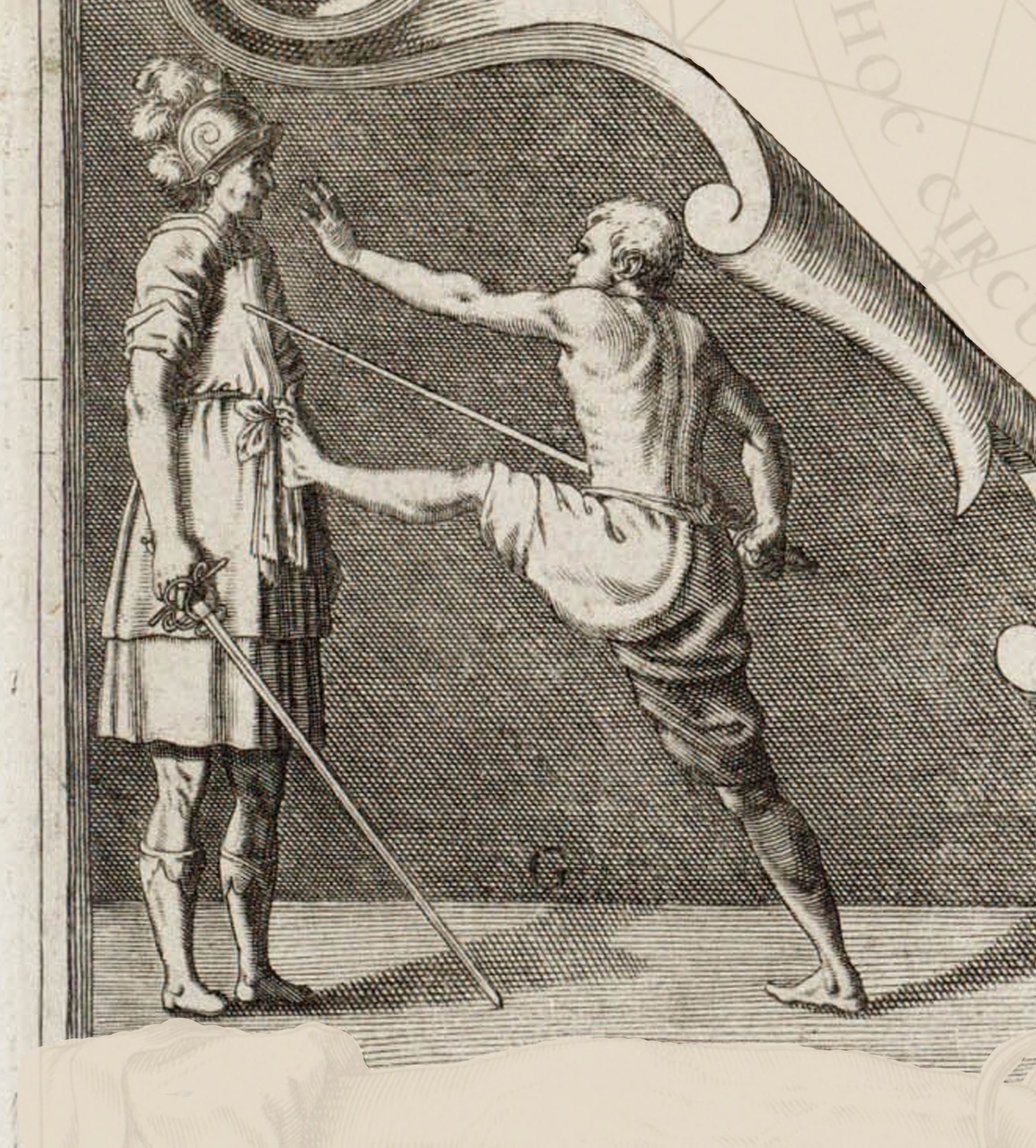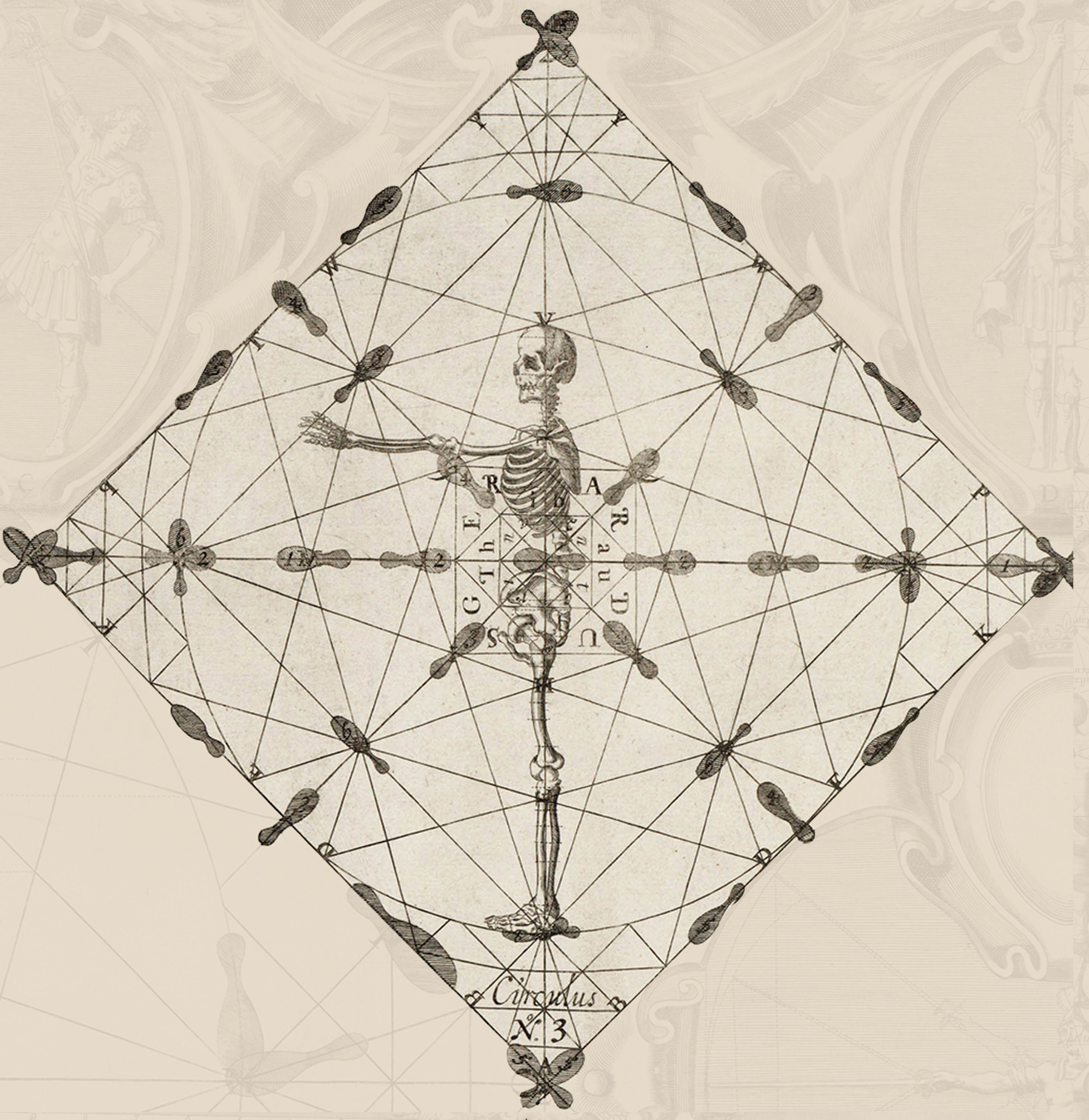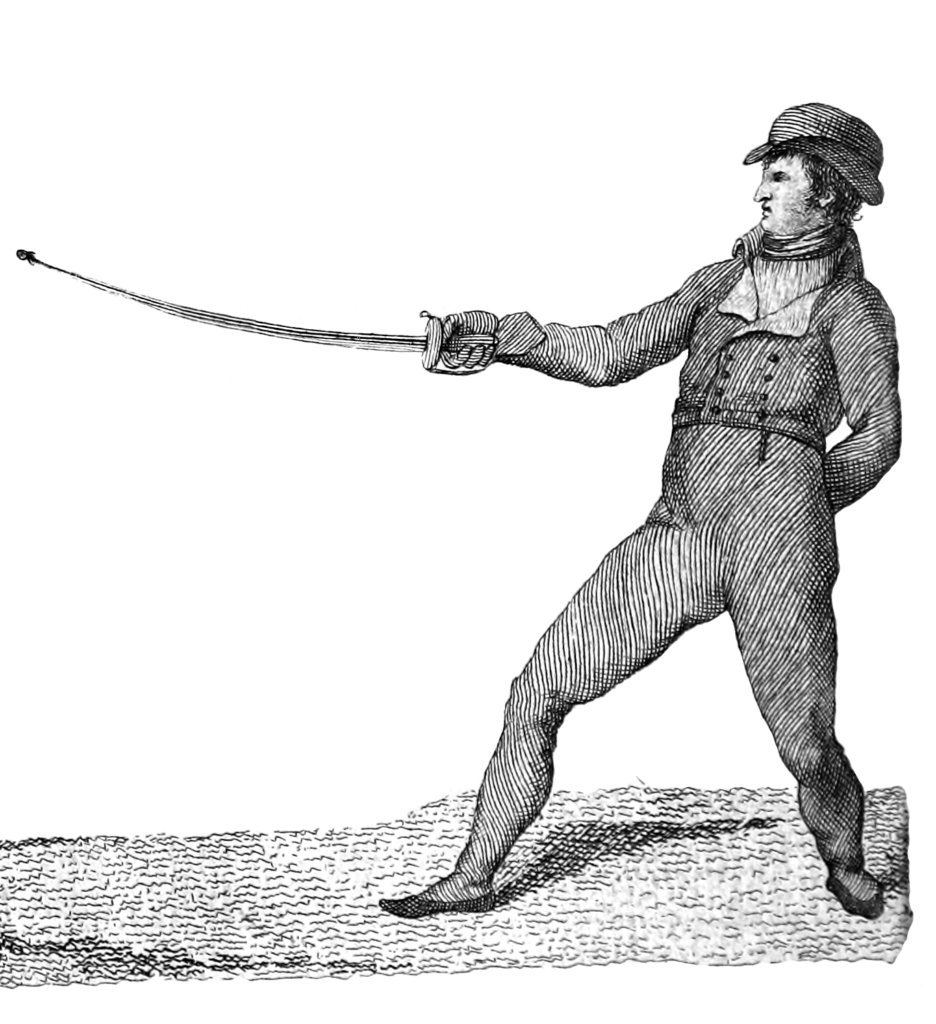448. It is necessary not to cut from this volume the treatment with extension on the oppositions that can be made by a skillful sabreur against the sword and foil. If you attend to the views of some aficionados of one or another weapons who, passionate with excess for what they profess, they fall into the error of judging that only the one of its use is capable of supporting what the sciences of weapons teaches to oppose others with advantage. But, as this is nothing but partisan passion, the sabreur must understand that this science is one in all weapons, and if the authors have been served in some particular by treating with that science, it has been because that has had more use in the countries where they have lived, and they have taken it purely as an instrument for its practical demonstration.
449. It is constant that the sciences all treated by the cultured nations, do not vary in object from variance of language, so that of the weapons conserves it without preventing the difference of instruments, looking in all equally to the defense of self and, if appropriate, offense of the contrary, though each one by its different construction, so in the guard, as in the blade, has some uses that are particular. An evident conclusion is therefore suggested, that the skillful fencer who does not have a principled knowledge of these particularities will not be able to make use of any other weapon than that in which he was taught, nor throw against another, even in the event of need, without exposure to evident danger.
450. Although the exercise of weapons is infallible by reason of its foundations, it is at the same time very changeable because of the instruments that we use, because those being of a different figure, the mechanism of its use is equally different. The sword, for example, equipped with a guard whose shell must be one sixth in diameter, and some quillions one third in length, requires less movement of just the hand to form angles with the opposing sword of a sufficient number of degrees. Consequently, the defensive movements in it require fewer notes than in the foil, since, in this, nearly the whole arm is required to entrust the defense.
451. In the sabre, there is not found a guard as capable as in the sword, but the curvature of the blade is an equivalent for the same effect and provides other resources that are exclusive to it. More so on your own side of the removals in the guard, except for the quillions, it is comparable to the sword. This, having a rather long blade, achieves a measure for the offenses greater than the other weapons, but the sabre has the great use of the counter edge that the sword does not know, because, although it has two edges, lacking the construction that favors the other, it also lacks such an effective use. For the cuts, there is similarly considerable advantage that the curvature of the sabre makes over the sword. For even if it is assumed to be equally sharp as another blade, the power will always be on the part of the curvature.
452. The foil, deprived of a guard sufficient for defense, and of a powerful edge has, in recompense for its construction and size, a lightness that greatly exceeds the other two, both for offense and for defense, but its reach is limited compared with the others. The foilist can be offended from a distance useless for his instrument. Therefore, the blows of the counter edge and edge to the arm and leg are some of the offenses that can hardly be avoided against the sabre, the same with timed blows when they are permitted, or when they cannot avoid the offensive measure, as, in this case, the convex part of the blade provides an opposition that is not permitted to the straight weapons.
453. Although the sword does not have the use of the counter edge to oppose the foil, it has the timed blows that, by the great defense of its guard and greater reach, are as powerful as they are safe. The practice that is acquired in the sabre of removing and offending while leaping back is not without advantage, when the occasioned and the place advise. It is true that other weapons have the same resources (only for defense), but it is also true that there is no custom of using them.
454. If I were to undertake here to deal with all of the variations that the handling of weapons admits with respect to their different figures, this would be a little bit of a growing volume. But, as these elements do not allow so much expansion, being satisfied with only what I have said above, I will add only one or another notes of how the study best works, the practice with the most skilled attackers, and the exercise of more than twenty one years both of sword and dagger, as of foil, and sabre, fighting interchangeably now with equal weapons, or now with any of them against the others, considered by me to be general and useful.
455. The lack of knowledge in the peculiarities of each weapon, privileges of its construction, and fundamentals of the skill that is found in most teachers makes them experience, to their regret in demonstrations of fighting with batons, the greatest afflictions and perplexities in the tricks or shots that, in the same time, the competitors execute. But then, how would it be if they fought with sharp weapons?
456. For this reason, many unfounded disputes are raised out of ignorance. As the famed Marquis de Rada says in many parts of his work, “Science, Art, and Experience of the Sword,” and in book three of the Experience, folio 470: “The fencers* do what they see done, without looking at the foundation of why it is done, nor if it is good or bad and, as always, the vulgar ignorance with credulous ease, by imitation, going after what is popular and not pursuing the science and the infallible effects on which it is founded. If any of their teachers are asked why they do it, they respond by saying that the sword will tell. And when they hit with some of their tricks or propositions (which is always by chance) as, by where and by what cause they did it, this way they will meet with folly. And the most prudent, recognizing their flaw, say they do not know (few there are that, deposing vanity, confess the truth so clearly), and it is rare among them who distinguishes the good or the bad of what they profess, and so always his works are as obscurely executed, dubious, harmful, and misleading for lack of real and true knowledge of the things that they profess.”
*An ignominious name that should only be given to the vulgar.
The “ignominious name” that I have rendered as “fencers” is, in the original Spanish “esgrimidores.”
457. Whenever the sabreur has to battle against the sword, be certain when it is advisable to attack. Do it with sufficient opposition of the arm and weapon, whether in response or in first intention*, with the aim of avoiding what are called the timed blows occupying the right angle, which those who use it often visit. When repairing the offenses of the enemy hold their sword when possible without deviating from the rules and, on the removals, reply with greatest speed by the weapon, or gain a conclusion or a hand blow.
*Understand by attack of first intention, when they attack to the enemy from the defensive measure to begin a battle.
458. The above statement does not prevent concluding on the removals that oppose to the thrusts and cuts that are inflicted, nor for the cutting blows to the arm or leg. Much care should be taken with the guard, not to expose it to suffer being concluded but, when your enemy tries it, find a prompt and just opposition. Under these precepts and the necessary exercise contained in this treatise, you will not find anything in fights against the sword which will surprise or embarrass the exercise of your own weapon. Note that the defensive measure chosen for the battle will always be with respect to the longer weapon (§ 50).
459. When it is offered to the sabeur to battle against the foil, walk a little bit out of the defensive distance, making attacks with the right foot on the ground* and always present the point of the sabre to the face of the enemy so that they desire to separate, removing his foil from the line of the diameter to one side or the other, and uncovering the wrist or knee where you will go frequently. The blows you have to execute to these points, effect them with rigor, secure that the reach you have for them, your opponent will not have at the same time with their point without closing the distance and, when they do, try to keep the first measure you took, executing these blows at the same time. But, if the foilist begins the battle by stepping deeply, make a withdrawal with a leap back in the same moment, offending with the half cut or reverse to the underside of the arm. They must, according to good academics, raise the hand to the height of the head to throw the thrusts, therefore, you will uncover sufficient points to execute such timed blows.
*The name attack of the foot is given to the operation that was ordered to be done on those in haste (§§ 298, 299, & 300)
460. If, in the execution of these shots, he brings his hand lower than the shoulders, you will execute the timed blows to the arm with vertical cuts with a leap back. If the terrain does not allow withdrawing, the sabreur will assert the guard of third, whether touching the foil or not, and from there, with the greatest speed, oppose to his thrust, a timed blow of first with the hand in high fourth*, measuring by means of the balances the precise distance for the reach of his weapon.
*Foilists call this a semicircular thrust.
461. If the foilist stands firm without the resolution to come deep, you must remain in the guard of third, or fourth, or common. If any of the first provocations is a free thrust, in order to take advantage of the movement of your removal to achieve a cut to the arm or leg, if you remain in the common, take the weapon at the same time with utmost violence, go deep with a thrust on his foil, making in him some force to compel him to remove it by opening his arm, and giving place with this to gain such blows or a conclusion, taking care to do it with much violence. Otherwise you could receive a response as prompt as the light weight of the weapon, along with the habit of handling it with speed will permit.
462. You can also practice a thrust by the foil when the sabreur takes one of the guards stated above (which are the most secure) to wait for the foilist, if they are not determined to go deep, by changing the step. Similarly, you can execute a cut to the arm or leg if, making a strong attack of the foot on the ground, he rushes to the chest or face without union of weapons, uncovering these points in this way.























